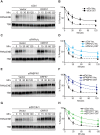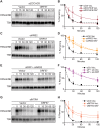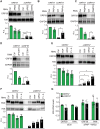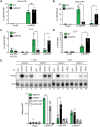Kaposi's sarcoma-associated herpesvirus ORF57 protein protects viral transcripts from specific nuclear RNA decay pathways by preventing hMTR4 recruitment
- PMID: 30785952
- PMCID: PMC6398867
- DOI: 10.1371/journal.ppat.1007596
Kaposi's sarcoma-associated herpesvirus ORF57 protein protects viral transcripts from specific nuclear RNA decay pathways by preventing hMTR4 recruitment
Abstract
Nuclear RNAs are subject to a number of RNA decay pathways that serve quality control and regulatory functions. As a result, any virus that expresses its genes in the nucleus must have evolved mechanisms that avoid these pathways, but the how viruses evade nuclear RNA decay remains largely unknown. The multifunctional Kaposi's sarcoma-associated herpesvirus (KSHV) ORF57 (Mta) protein is required for the nuclear stability of viral transcripts. In the absence of ORF57, we show that viral transcripts are subject to degradation by two specific nuclear RNA decay pathways, PABPN1 and PAPα/γ-mediated RNA decay (PPD) in which decay factors are recruited through poly(A) tails, and an ARS2-mediated RNA decay pathway dependent on the 5' RNA cap. In transcription pulse chase assays, ORF57 appears to act primarily by inhibiting the ARS2-mediated RNA decay pathway. In the context of viral infection in cultured cells, inactivation of both decay pathways by RNAi is necessary for the restoration of ORF57-dependent viral genes produced from an ORF57-null bacmid. Mechanistically, we demonstrate that ORF57 protects viral transcripts by preventing the recruitment of the exosome co-factor hMTR4. In addition, our data suggest that ORF57 recruitment of ALYREF inhibits hMTR4 association with some viral RNAs, whereas other KSHV transcripts are stabilized by ORF57 in an ALYREF-independent fashion. In conclusion, our studies show that KSHV RNAs are subject to nuclear degradation by two specific host pathways, PPD and ARS2-mediated decay, and ORF57 protects viral transcripts from decay by inhibiting hMTR4 recruitment.
Conflict of interest statement
The authors have declared that no competing interests exist.
Figures







Similar articles
-
Kaposi's Sarcoma-Associated Herpesvirus Fine-Tunes the Temporal Expression of Late Genes by Manipulating a Host RNA Quality Control Pathway.J Virol. 2020 Jul 1;94(14):e00287-20. doi: 10.1128/JVI.00287-20. Print 2020 Jul 1. J Virol. 2020. PMID: 32376621 Free PMC article.
-
Kaposi's sarcoma-associated herpesvirus ORF57 protein binds and protects a nuclear noncoding RNA from cellular RNA decay pathways.PLoS Pathog. 2010 Mar 5;6(3):e1000799. doi: 10.1371/journal.ppat.1000799. PLoS Pathog. 2010. PMID: 20221435 Free PMC article.
-
Kaposi's sarcoma-associated herpesvirus ORF57 protein enhances mRNA accumulation independently of effects on nuclear RNA export.J Virol. 2007 Sep;81(18):9990-8. doi: 10.1128/JVI.00896-07. Epub 2007 Jul 3. J Virol. 2007. PMID: 17609285 Free PMC article.
-
KSHV ORF57, a protein of many faces.Viruses. 2015 Feb 10;7(2):604-33. doi: 10.3390/v7020604. Viruses. 2015. PMID: 25674768 Free PMC article. Review.
-
The KSHV RNA regulator ORF57: target specificity and its role in the viral life cycle.Wiley Interdiscip Rev RNA. 2016 Mar-Apr;7(2):173-85. doi: 10.1002/wrna.1323. Epub 2016 Jan 14. Wiley Interdiscip Rev RNA. 2016. PMID: 26769399 Review.
Cited by
-
Functional analysis of 3'-UTR hairpins supports a two-tiered model for posttranscriptional regulation of MAT2A by METTL16.RNA. 2023 Nov;29(11):1725-1737. doi: 10.1261/rna.079695.123. Epub 2023 Aug 11. RNA. 2023. PMID: 37567786 Free PMC article.
-
Role of human herpesvirus homologs of infected cell protein 27 (ICP27) in the biogenesis, processing, and maturation of mRNAs.mBio. 2025 Apr 9;16(4):e0029125. doi: 10.1128/mbio.00291-25. Epub 2025 Mar 4. mBio. 2025. PMID: 40035535 Free PMC article. Review.
-
Exploration of RNA-binding proteins identified RPS27 as a potential regulator associated with Kaposi's sarcoma development.BMC Cancer. 2025 Feb 27;25(1):362. doi: 10.1186/s12885-025-13790-0. BMC Cancer. 2025. PMID: 40016701 Free PMC article.
-
NCBP3: A Multifaceted Adaptive Regulator of Gene Expression.Trends Biochem Sci. 2021 Feb;46(2):87-96. doi: 10.1016/j.tibs.2020.09.003. Epub 2020 Oct 5. Trends Biochem Sci. 2021. PMID: 33032857 Free PMC article. Review.
-
SAM homeostasis is regulated by CFIm-mediated splicing of MAT2A.Elife. 2021 May 5;10:e64930. doi: 10.7554/eLife.64930. Elife. 2021. PMID: 33949310 Free PMC article.
References
-
- Ruocco E, Ruocco V, Tornesello ML, Gambardella A, Wolf R, Buonaguro FM. Kaposi’s sarcoma: etiology and pathogenesis, inducing factors, causal associations, and treatments: facts and controversies. Clin Dermatol. 2013;31(4):413–22. Epub 2013/06/29. 10.1016/j.clindermatol.2013.01.008 . - DOI - PMC - PubMed
-
- Staudt MR, Dittmer DP. Viral latent proteins as targets for Kaposi’s sarcoma and Kaposi’s sarcoma-associated herpesvirus (KSHV/HHV-8) induced lymphoma. Curr Drug Targets Infect Disord. 2003;3(2):129–35. Epub 2003/05/29. . - PubMed
-
- Arias C, Weisburd B, Stern-Ginossar N, Mercier A, Madrid AS, Bellare P, et al. KSHV 2.0: a comprehensive annotation of the Kaposi’s sarcoma-associated herpesvirus genome using next-generation sequencing reveals novel genomic and functional features. PLoS Pathog. 2014;10(1):e1003847 Epub 2014/01/24. 10.1371/journal.ppat.1003847 . - DOI - PMC - PubMed
Publication types
MeSH terms
Substances
Grants and funding
LinkOut - more resources
Full Text Sources
Research Materials
Miscellaneous

